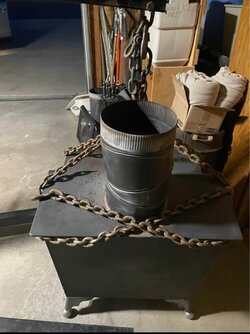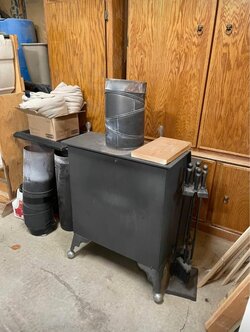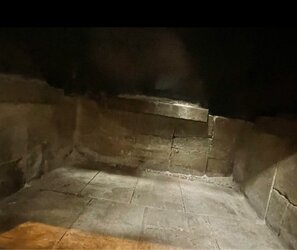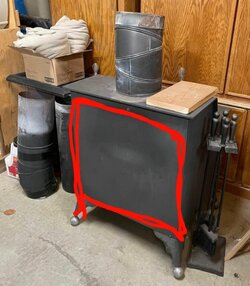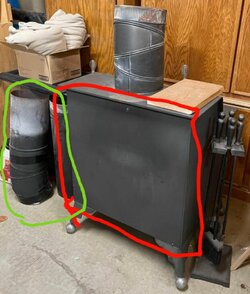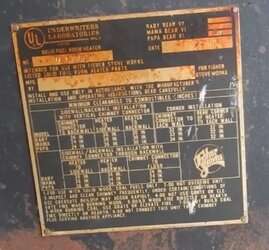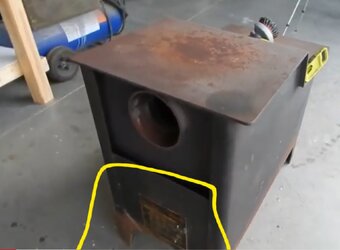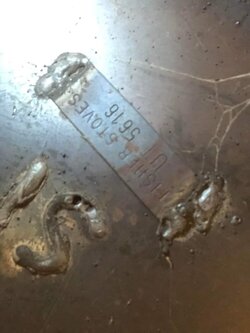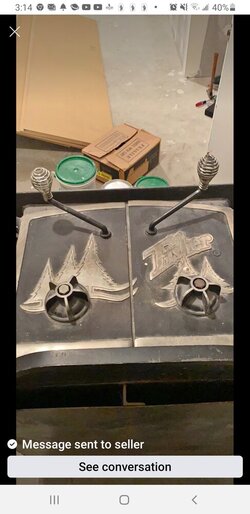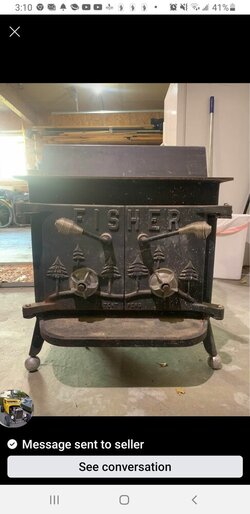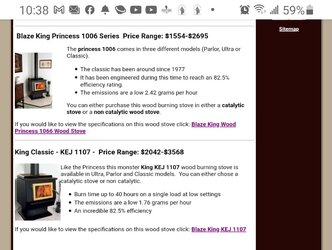If you don't mind saying what did it cost you?This one. It was inexpensive and in good shape.
View attachment 294938
Want to get a Fisher
- Thread starter FisherStove
- Start date
-
Active since 1995, Hearth.com is THE place on the internet for free information and advice about wood stoves, pellet stoves and other energy saving equipment.
We strive to provide opinions, articles, discussions and history related to Hearth Products and in a more general sense, energy issues.
We promote the EFFICIENT, RESPONSIBLE, CLEAN and SAFE use of all fuels, whether renewable or fossil.
You are using an out of date browser. It may not display this or other websites correctly.
You should upgrade or use an alternative browser.
You should upgrade or use an alternative browser.
Since we bought the Listed Grandma III it will be nice if it's a usable one, even if it doesn't work for our space.
Our add-on family room is about 700-800 sf but has 9' ceilings and French doors to the rest of the house. It has 3 large windows. We recently removed the aluminum singles and put new double pane around the house.
The bedroom add-on is about 300 sf and has a single door to the house.
The rest of the main floor is 1,300 sf.
The upstairs is 1,300 sf.
The basement and attic are smaller and we are not concerned with heating them really, except to keep pipes from freezing in the basement.
The furnace is in the basement and heats that space.
The furnace heats the 2,600 sf main floor(1,300sf) and upstairs(1,300sf) space.
It would be nice to have solar and/or woodstove backup for everything but we at least would like to heat the 700sf-800sf 9' ceiling family room and extra heat can go to the rest of the space and take some of the burden off of the furnace.
Any recommendations welcomed, please?
Our add-on family room is about 700-800 sf but has 9' ceilings and French doors to the rest of the house. It has 3 large windows. We recently removed the aluminum singles and put new double pane around the house.
The bedroom add-on is about 300 sf and has a single door to the house.
The rest of the main floor is 1,300 sf.
The upstairs is 1,300 sf.
The basement and attic are smaller and we are not concerned with heating them really, except to keep pipes from freezing in the basement.
The furnace is in the basement and heats that space.
The furnace heats the 2,600 sf main floor(1,300sf) and upstairs(1,300sf) space.
It would be nice to have solar and/or woodstove backup for everything but we at least would like to heat the 700sf-800sf 9' ceiling family room and extra heat can go to the rest of the space and take some of the burden off of the furnace.
Any recommendations welcomed, please?
Most stoves are going to cook you out of that 700 to 800 SQ ft room. That Fisher certainly willSince we bought the Listed Grandma III it will be nice if it's a usable one, even if it doesn't work for our space.
Our add-on family room is about 700-800 sf but has 9' ceilings and French doors to the rest of the house. It has 3 large windows. We recently removed the aluminum singles and put new double pane around the house.
The bedroom add-on is about 300 sf and has a single door to the house.
The rest of the main floor is 1,300 sf.
The upstairs is 1,300 sf.
The basement and attic are smaller and we are not concerned with heating them really, except to keep pipes from freezing in the basement.
The furnace is in the basement and heats that space.
The furnace heats the 2,600 sf main floor(1,300sf) and upstairs(1,300sf) space.
It would be nice to have solar and/or woodstove backup for everything but we at least would like to heat the 700sf-800sf 9' ceiling family room and extra heat can go to the rest of the space and take some of the burden off of the furnace.
Any recommendations welcomed, please?
Well, if the French doors are open to the rest of the house maybe it will be okay? We froze out with the insufficient mini-split.
I really don't think it would be underneath. Why would lifting with chains matter? It will scratch the paint but otherwise it won't matterWe are really not sure we would like them lifting it with chains from the top.
I wouldn't lift a cast stove that way but as long as I didn't care about the paint I wouldn't worry about any plate steel stove
Less than most for sale. If it doesn't have the UL tag we might ask if we can pay less or something since it really cannot be installed and used in that case. Bummer is, most of the Fishers are not listed. People don't know all these detail rules going into it. It had been listed for awhile so maybe most do know..If you don't mind saying what did it cost you?
If the tag is still on it, it will be on the back on the heat shield on that model. That will heat 1750 sf with 8 foot ceiling. It has an internal baffle that raises heating capacity from 1500 without baffle added in 1980 to that model.
If you google the state and “building code”, that will give you the code adopted statewide. If it is International Code, that adds all appliances must be UL Listed with label attached. This was to prevent homemade unsafe stoves from being installed. The requirement is for installation only. Any already installed are grandfathered unless in a state or locality that requires their removal when home is sold. Many insurance companies require UL Listing as well.
Nationwide the US uses NFPA 211 Standard which codes adopt. Then some codes add their own regs making it more strict. They can add to it, but not take anything away. So installed to the NFPA Standard it will be safe, but possibly not legal depending on which code is adopted for the area.
If using the fireplace chimney you will need a full liner no mater what you go with. When you change the use from fireplace to stove or insert, it needs to be brought up to current code. The diameter of existing flue determines how easy this will be to do. If masonry is in contact with combustible framing, with less than a foot of solid masonry, the liner must be insulated. ALL stoves benefit from an insulated liner. The issue is many times the original flue tiles will need to be removed to fit the insulated liner. So measuring the existing flue size is the best place to start.
Get firewood now for next season burning. Don’t expect anything you buy or cut to be ready to burn for at least a year. Up to 3 for some species.
If you want big heat, lots of BTU to warm a cold space, the Fisher Stove is fine. The Inserts have a cooktop where half the Insert sticks out of the hearth. You won’t find that on newer Inserts. Fishers or any older stoves are more lenient on fuel that is slightly damp or a little over 20% moisture content, but they still work much better with good dry wood. Newer stoves require dryer wood. They will burn MUCH longer. Catalytic stoves have the longest burn times. You won’t get much heat out of them turned down, but they can extend your burning season with less output. As an example, the Blaze King Princess with 6 inch vent will burn 30 hours. The King model with 8 inch vent burns 40. They have a thermostat, you set it and forget it for that long to reload. Completely different technology and they burn that long, that low smokeless. The other design is a secondary burn stove that burns the smoke particles in the stove instead of wasting the heat in the smoke up the chimney, polluting the air and forming creosote. Fishers have their place, your home is not one of them if you want efficiency. If you have a shed or large barn to bring up from outdoor temperature, a Fisher will do that, going through much more wood in the process. These newer EPA Certified stoves will cut your fuel usage by 1/3.
They do have parts such as insulated baffles, secondary burn tubes and catalytic combustors that are not as heavy duty as a Fisher. But needing to change any parts as they wear out saves their cost in fuel used many, many times over.
If you google the state and “building code”, that will give you the code adopted statewide. If it is International Code, that adds all appliances must be UL Listed with label attached. This was to prevent homemade unsafe stoves from being installed. The requirement is for installation only. Any already installed are grandfathered unless in a state or locality that requires their removal when home is sold. Many insurance companies require UL Listing as well.
Nationwide the US uses NFPA 211 Standard which codes adopt. Then some codes add their own regs making it more strict. They can add to it, but not take anything away. So installed to the NFPA Standard it will be safe, but possibly not legal depending on which code is adopted for the area.
If using the fireplace chimney you will need a full liner no mater what you go with. When you change the use from fireplace to stove or insert, it needs to be brought up to current code. The diameter of existing flue determines how easy this will be to do. If masonry is in contact with combustible framing, with less than a foot of solid masonry, the liner must be insulated. ALL stoves benefit from an insulated liner. The issue is many times the original flue tiles will need to be removed to fit the insulated liner. So measuring the existing flue size is the best place to start.
Get firewood now for next season burning. Don’t expect anything you buy or cut to be ready to burn for at least a year. Up to 3 for some species.
If you want big heat, lots of BTU to warm a cold space, the Fisher Stove is fine. The Inserts have a cooktop where half the Insert sticks out of the hearth. You won’t find that on newer Inserts. Fishers or any older stoves are more lenient on fuel that is slightly damp or a little over 20% moisture content, but they still work much better with good dry wood. Newer stoves require dryer wood. They will burn MUCH longer. Catalytic stoves have the longest burn times. You won’t get much heat out of them turned down, but they can extend your burning season with less output. As an example, the Blaze King Princess with 6 inch vent will burn 30 hours. The King model with 8 inch vent burns 40. They have a thermostat, you set it and forget it for that long to reload. Completely different technology and they burn that long, that low smokeless. The other design is a secondary burn stove that burns the smoke particles in the stove instead of wasting the heat in the smoke up the chimney, polluting the air and forming creosote. Fishers have their place, your home is not one of them if you want efficiency. If you have a shed or large barn to bring up from outdoor temperature, a Fisher will do that, going through much more wood in the process. These newer EPA Certified stoves will cut your fuel usage by 1/3.
They do have parts such as insulated baffles, secondary burn tubes and catalytic combustors that are not as heavy duty as a Fisher. But needing to change any parts as they wear out saves their cost in fuel used many, many times over.
What many do, is install to the safe NFPA 211 Standard and claim the stove was existing, since the code is for installation, not the use of a pre-existing stove. You can change the pipe, and chimney and still be pre-existing, since it is difficult to tell when the stove was installed. Hence the used stove market.Less than most for sale. If it doesn't have the UL tag we might ask if we can pay less or something since it really cannot be installed and used in that case. Bummer is, most of the Fishers are not listed. People don't know all these detail rules going into it. It had been listed for awhile so maybe most do know..
It might be a good place to store emergency prep items in case of fire or earthquake it might be more likely to make it through  we can keep items that would be helpful in the 1st few days of an emergency. 1st aid, food, water, etc. We could pull all the stuff out and cook with the stove. We can store it in our shed to keep it out of the weather. Just thinking.
we can keep items that would be helpful in the 1st few days of an emergency. 1st aid, food, water, etc. We could pull all the stuff out and cook with the stove. We can store it in our shed to keep it out of the weather. Just thinking.
 we can keep items that would be helpful in the 1st few days of an emergency. 1st aid, food, water, etc. We could pull all the stuff out and cook with the stove. We can store it in our shed to keep it out of the weather. Just thinking.
we can keep items that would be helpful in the 1st few days of an emergency. 1st aid, food, water, etc. We could pull all the stuff out and cook with the stove. We can store it in our shed to keep it out of the weather. Just thinking.You would need a chimney to hook it to when you pull it out.It might be a good place to store emergency prep items in case of fire or earthquake it might be more likely to make it throughwe can keep items that would be helpful in the 1st few days of an emergency. 1st aid, food, water, etc. We could pull all the stuff out and cook with the stove. We can store it in our shed to keep it out of the weather. Just thinking.
This one?
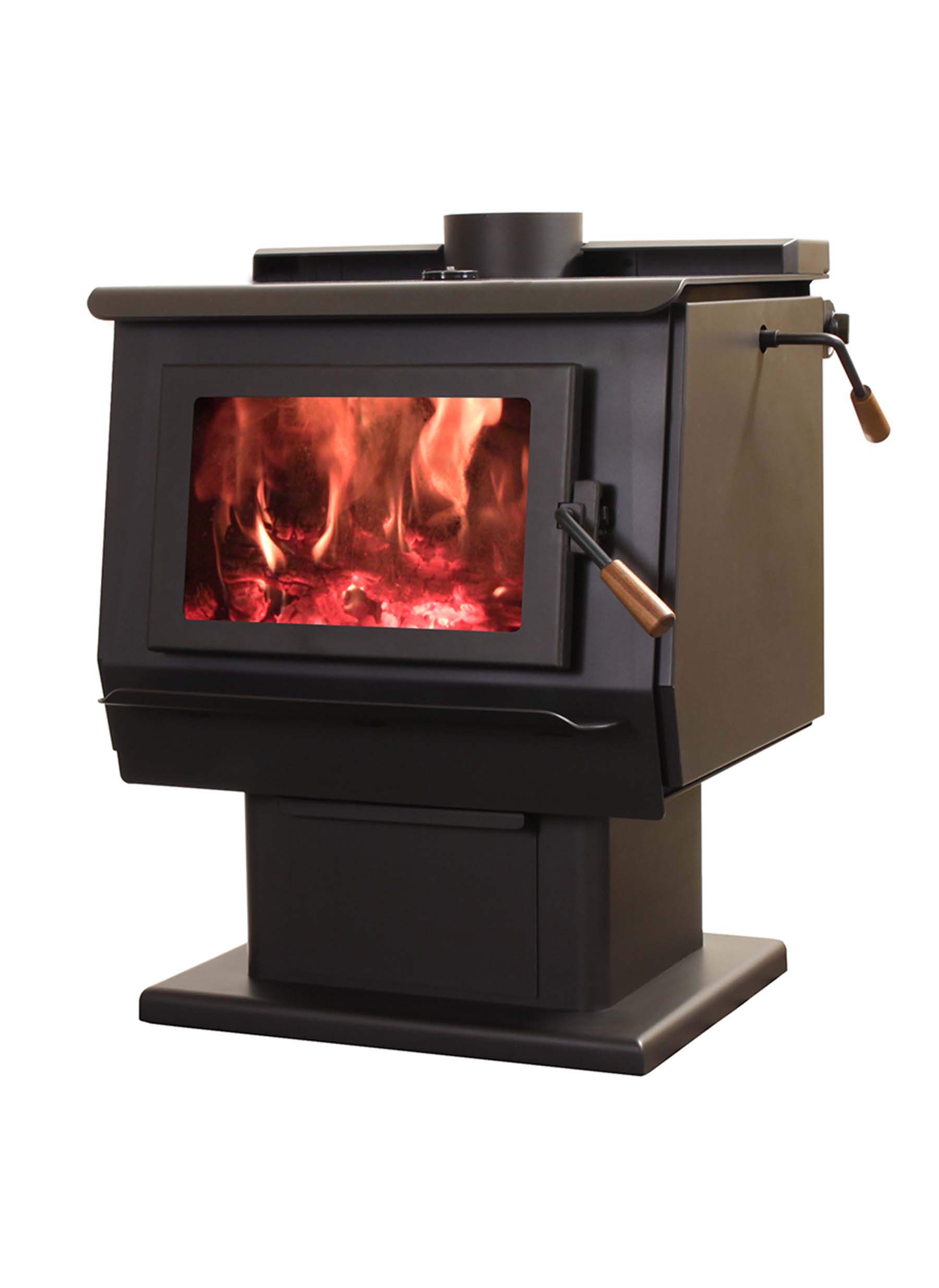
 www.blazeking.com
www.blazeking.com
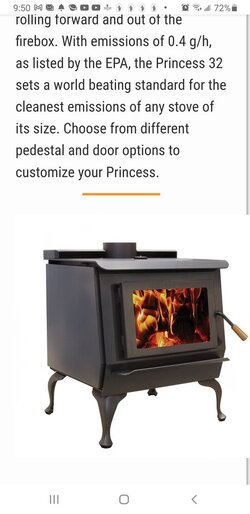

Princess 32 (PE32) - Blaze King
The Princess 32 (PE32) has a large 2.9 cu.ft. firebox and has a thermostat to automatically control the heat output (no electricity required). Our deep firebox design, 6” from the door opening to the bottom of the firebox, minimizes any chance of coals rolling forward and out of the firebox...

We have firewood from a tree we cut down a few years ago.
The secondary sounds interesting. I'll have to look it up.
What kind of chimney were you thinking of for when we pull out the Fisher?
The secondary sounds interesting. I'll have to look it up.
What kind of chimney were you thinking of for when we pull out the Fisher?
What kind of chimney were you thinking? There are the stove pipes. We're you thinking of a brick chimney or something?You would need a chimney to hook it to when you pull it out.
It doesn't matter what type. You just need some sort of chimney to creat draft without that the stove simply won't workWhat kind of chimney were you thinking? There are the stove pipes. We're you thinking of a brick chimney or something?
Similar threads
- Replies
- 5
- Views
- 682
- Replies
- 2
- Views
- 891
- Replies
- 1
- Views
- 883
- Replies
- 11
- Views
- 579


